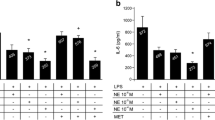Abstract
Objective: To characterize the impact of abdominal aortic aneurysm repair (AAAR) on spontaneous as well as lipopolysaccharide (LPS)-induced gene expression of pro- and anti-inflammatory cytokines. Design: Prospective, controlled in vivo / ex vivo study. Setting: University hospital. Patients and interventions: Whole blood from 14 consecutive patients undergoing AAAR withdrawn prior to surgery (T1), at the end of ischemia (T2), 90 min after declamping (T3) and on the first postoperative day (T4) was cultured in the absence or presence of LPS. Five patients undergoing elective inguinal hernia repair served as controls. Measurements and results: While tumor necrosis factor (TNF), Interleukin (IL)-1 and IL-10 plasma concentrations did not increase significantly, IL-6 was elevated at each time point, as compared with T1. Despite the spontaneous release of trace amounts of IL-6, the ability of cultured whole blood to mount a cytokine response in vitro to LPS was impaired for all cytokines studied at T2 (TNF –62 %, IL-1 –51 %, IL-6 –20 %, IL-10 –51 %). The stimulated IL-6 response was restored early after declamping (T3: + 56 %) and enhanced 1 day after operation (T4: + 144 %). In contrast, stimulated TNF and IL-1 responses remained depressed at T3 (TNF –48 %, IL-1 –64 %) and T4 (TNF –40 %, IL-1 –24 %). A biphasic pattern was observed for IL-10 with initial depression at T3 (-51 %) and restoration at T4 ( + 40 %). Among the different cytokines monitored, only impaired TNF responsiveness at early reperfusion (T3) correlated with the postoperative course, as reflected by APACHE II. Cytokine response to LPS was maintained or even increased during and after surgery in the whole blood from patients undergoing hernia repair. Conclusions: Despite consistent development of clinical signs of systemic inflammatory response syndrome (SIRS) and spontaneous release of IL-6 abdominal aortic aneurysm repair produces a state of impaired pro-inflammatory cytokine response upon a subsequent in vitro Gram-negative stimulus. This early impairment of TNF responsiveness seems to correlate with an unfavorable postoperative course.
Similar content being viewed by others
Author information
Authors and Affiliations
Additional information
Received: 17 April 1998 Final revision received: 22 July 1998 Accepted: 17 August 1998
Rights and permissions
About this article
Cite this article
Ziegenfuß, T., Wanner, G., Grass, C. et al. Mixed agonistic-antagonistic cytokine response in whole blood from patients undergoing abdominal aortic aneurysm repair. Intensive Care Med 25, 279–287 (1999). https://doi.org/10.1007/s001340050836
Issue Date:
DOI: https://doi.org/10.1007/s001340050836




